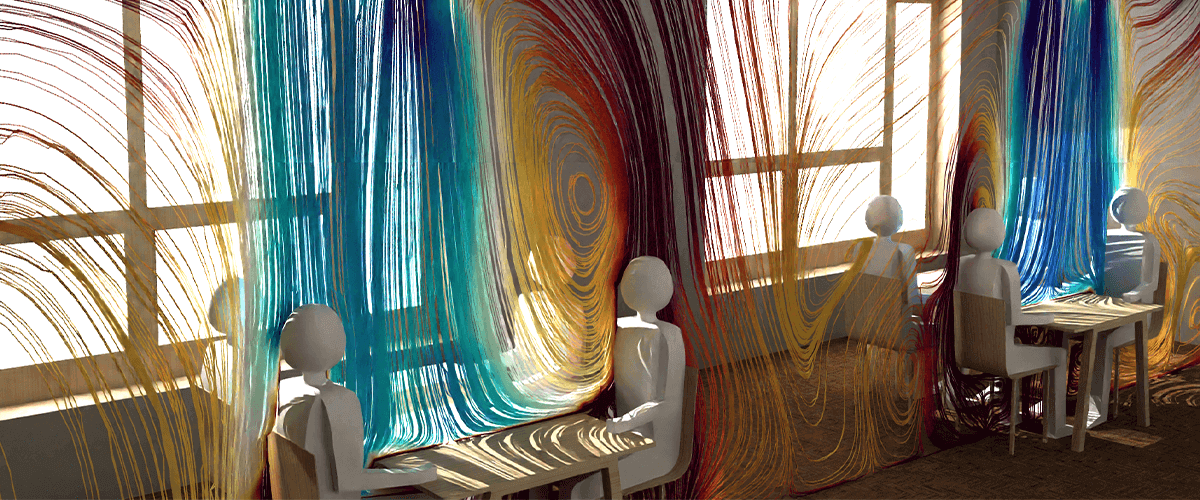Simulating and building the future with SimScale and BricsCAD.
Designing A Future Built Environment
A future built environment is coming where 80% of the global population will live in densely packed cities. Global megatrends, including urbanization, an ageing population, digital transformation, and, more recently, changing work patterns and behaviors, will place unprecedented demands on our buildings, cities, and infrastructure. Architecture and environmental design used to be about form, space layout, and sound design. They are now a complex, multi-disciplinary activity where health and wellbeing, energy/resource consumption, digital transformation, and public health are inextricably connected. Our buildings are becoming smarter, and they are adapting to a future world where climate change is a significant design consideration. From schools, hospitals, offices, retail, and transport infrastructure, every type of building has an evolving set of design parameters that need to be correctly understood, modeled, and fixed from the early design phase up to the technical detailing.

Integrating greening strategies into our cities is essential for making healthy and liveable places.
A new set of technologies and software is needed to keep pace with these increasing demands and adaptations. A new generation of building physics tools are required to capture the dynamic behavior of buildings and the environment. A new set of fundamental CAD and generative design tools are needed, powered by artificial intelligence (A.I.) that can aid in the generation and selection of multiple competing design variants and assist decision-makers in arriving at the optimal solution. These new tools need to be linked to benefit from their respective and unique capabilities; thus, the cloud and other collaboration tools must be swiftly adopted by the architecture, engineering, and construction industry (AEC).
Bricsys is a world-leading provider of affordable, modern Computer-Aided Design (CAD), Building Information Modeling (BIM), Mechanical Design (MCAD) and cloud-based Common Data Environment (CDE) products, brought to market under the BricsCAD & Bricsys 24/7 brands. SimScale has developed the world's first cloud-based engineering and simulation platform for modeling the built environment. Both Bricsys and SimScale are committed to enabling a sustainable future for our buildings and cities by providing state-of-the-art software for designers, architects, and engineers -- all those involved in building the future.
Building the Future with BricsCAD
Understanding how high-performing design teams work productively is the key to how the BricsCAD products are designed and developed. With an early focus on optimizing design workflows, Bricsys has been able to create a suite of CAD and BIM design tools for architects, engineers, and BIM professionals that are used globally on building, civil, mechanical, and infrastructure projects. One of the key features that enable an actual multi-disciplinary ability for users is the development of third-party applications using an open API. Bricsys has facilitated an ecosystem of useful tools that are essential for designing and building a future world. Users can access software components to create everything from central utility plant and structural building components to a building's heating, ventilation, and air conditioning (HVAC) equipment. Larger scale tools for understanding a development site are also available, such as the GIS third-party applications. Importantly, this network of third-party developers has given rise to creativity and innovation that is organically growing overall software capabilities.
A more recent advance has been the integration of A.I. algorithms in BricsCAD BIM, allowing a more automated method to specify, enter and document the vast amounts of data needed to develop BIM models competently. The time-saving productivity implications of these features directly lead to non-trivial project cost savings. Finally, Bricsys is continuously expanding its ecosystem of applications that connect with BricsCAD, including design tools like Grasshopper, GIS and HVAC design, supplementing the user's workflow with their specific capabilities. Through the API, a user can integrate many unique software tools. It is open-minded thinking that allows designers, architects, and engineers globally to maximize their knowledge and creativity.

Grasshopper, in BricsCAD BIM. Used to create complex geometry otherwise unattainable with traditional CAD methods.
Simulating the Future with SimScale
SimScale is a leader in computational fluid dynamics (CFD) on the cloud. CFD is easily accessible via a web browser, without the need for local hardware. For the first time, CFD is now open to anyone who has access to the world wide web, thus bringing a traditionally esoteric and difficult to use application; to a simple to use platform. The SimScale free plan is used by over 200,000 people globally and is driving the adoption of fluid dynamics in a cost-effective and scalable manner.

CFD simulation of airflow around a building
The ability to conveniently import many types of 3D models is critical for allowing designers and architects to evaluate their design options. Historically, it has been the bottleneck in many simulation programs. It arises from traditional physics programs based on the Finite Volume Method (FVM), which requires a water-tight geometry to be able to discretize the 3D domain. A 3D model must have much time spent on it to 'clean' up the model, make it water-tight, and then use simulation to evaluate designs. This process is known to be cumbersome and resource-intensive. SimScale has a new generation of physics solvers based on the Lattice Boltzmann Method (LBM). They are sufficiently different from FVM methods to bypass the geometry cleaning issues. LBM simulations for modeling wind comfort, for example, do not need CAD clean up as their solving techniques are impartial to small holes and intersections in the geometry. Because SimScale runs on the cloud using GPU accelerated infrastructure, the simulations are optimized to run in parallel as much as possible, giving them a significant advantage in solving times. Transient wind analysis (Simulating a real wind) of a city centre, for example, can be run an order of magnitude faster than traditional CFD software. Architects and engineers are using SimScale for environmental design by applying CFD to buildings and cities.

Environmental Design for Building the Future
Design tools make a valuable contribution to the work architects and engineers undertake in developing our buildings and cities. A well-crafted design software tool empowers users to leverage their creativity and assist in transforming their ideas into working CAD and BIM models. Simulation and modeling tools allow designers to quantify their designs against environmental design variables such as the changing climate. A design or engineering team needs scalable tools that can connect and offer broad, evolving capabilities. Both Bricsys and SimScale have open APIs, allowing them to connect and leverage each other's abilities. This organic network of environmental design tools will enable a well designed, future built environment.


